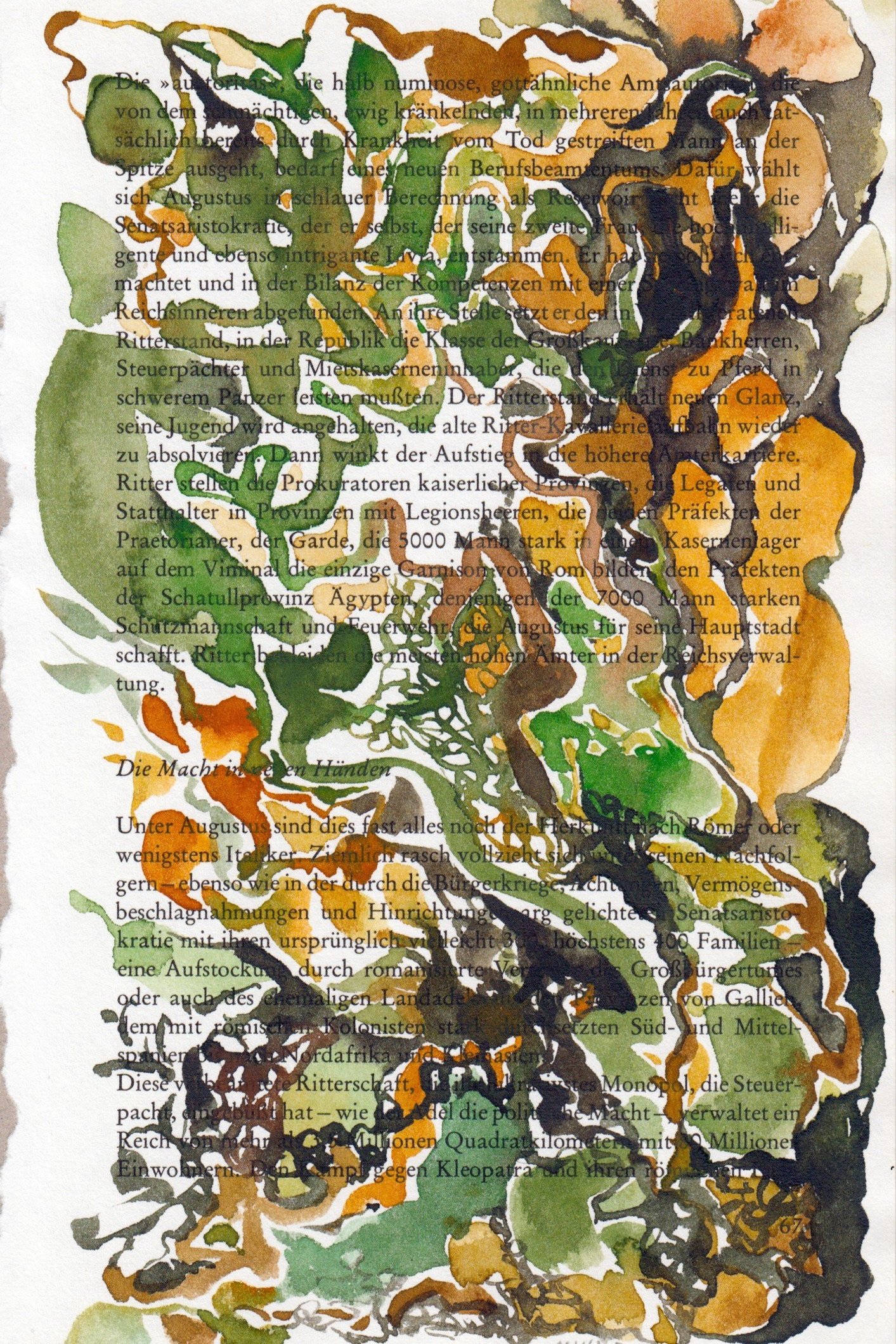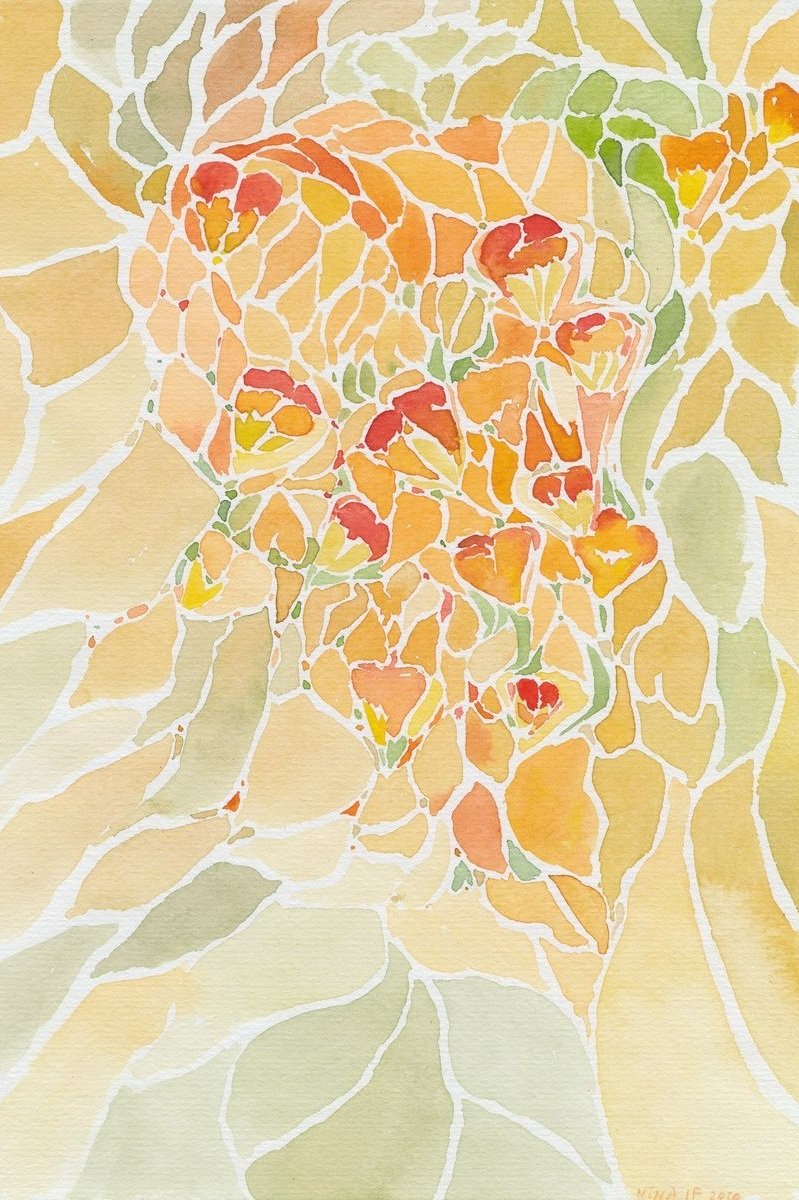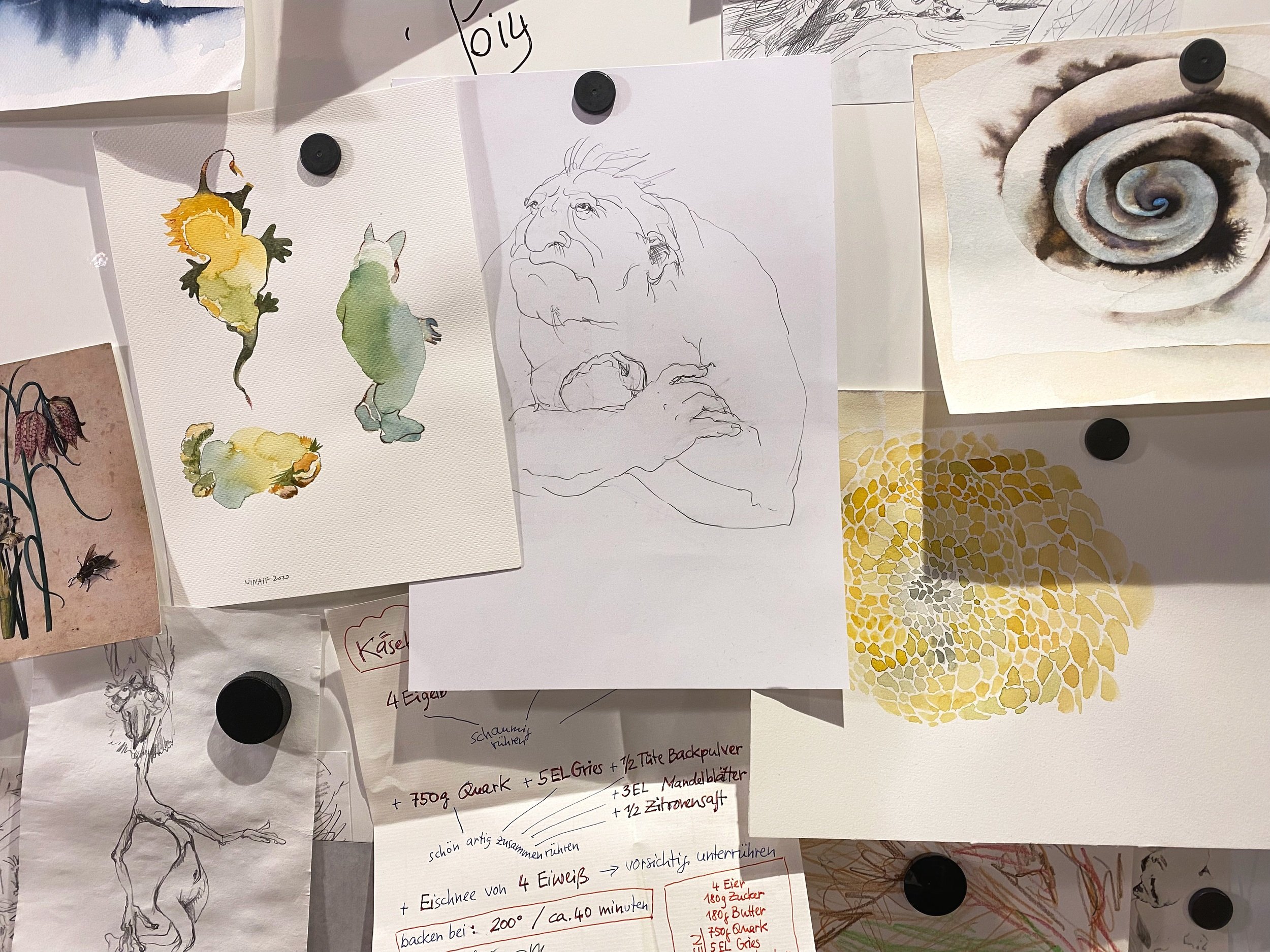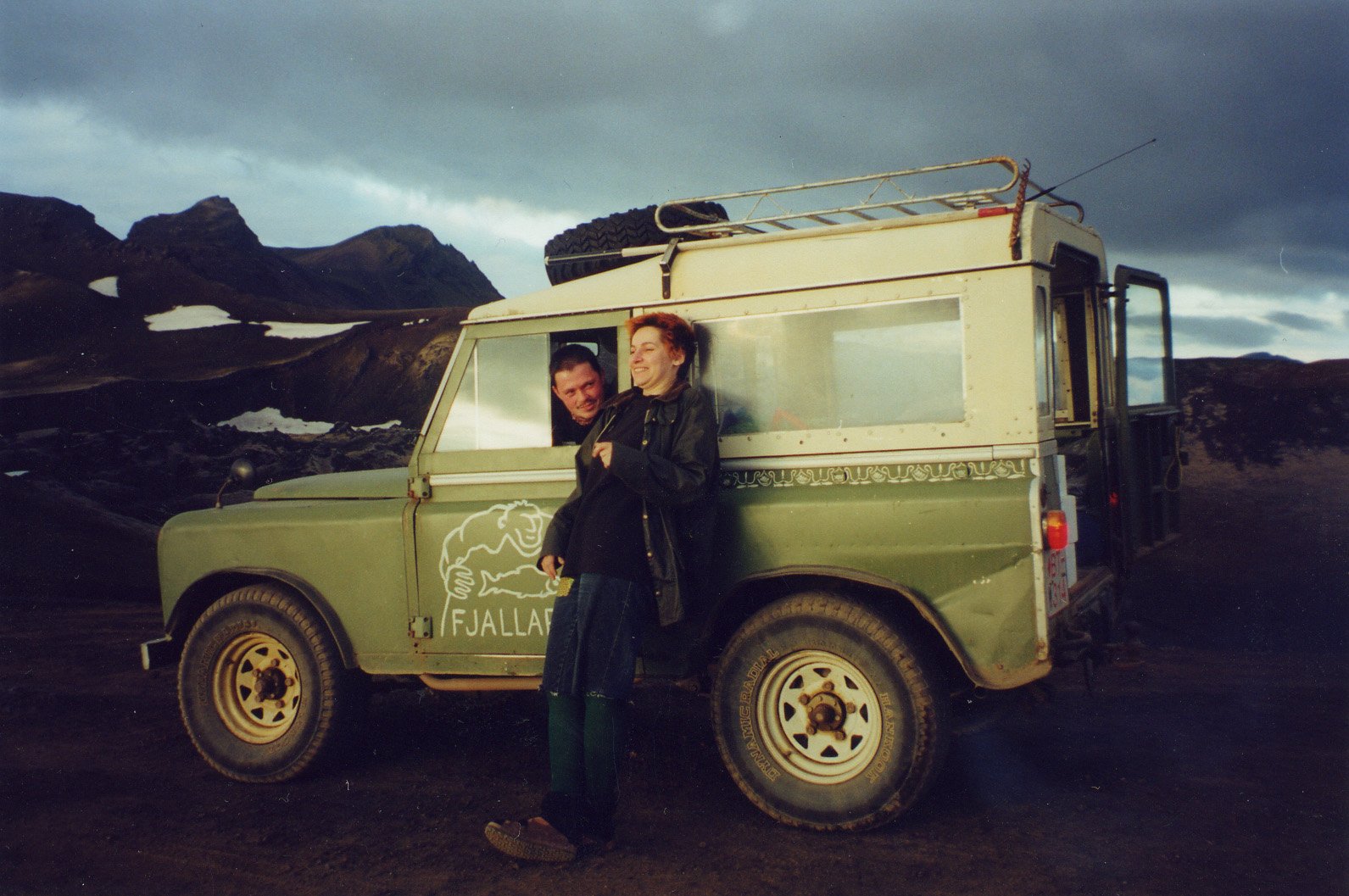Nína
Ivanova
ArtistNína works with conceptual art, installations, art objects, murals, design in many areas, illustrations in books and watercolors.
Our first meeting with Nína and Smári at their home was enchanting. Under the staircase, on top of columns of books, in the little nooks in the walls, one could easily find collaged images, little objects and figurines staged as if they would re-animate when no one was looking.
I was enchanted by how they had breathed life and imagination into their everyday life. The warm and whimsical atmosphere, accompanied by fine bancha, classic Russian sweets, and little gems of funny exchanges had me mesmerized. In their home, life and art fused into a wonderful dance. In one moment, it was a whirlwind of excitement from Nína, then the next came the perfect balance of Smári’s grounded little grin and a nod.
Both of them were artists and often collaborated with each other, although their approach to art and studio decorations could not be more different. Nína’s studio was outfitted with warm shades of wood, colors and painting tools; Smári’s had white walls, two large computer screens and a detailed map of Iceland. For Nína, her art process often began with playing. It was a smooth flow where time slowed down.
To Smári, time speeded up and passed by without him noticing.
He found beauty in the practical and well-designed. Together they moved around in harmony. Nína carefully prepared us tea, then Smári followed us with all five of our unfinished cups when we whisked our way into Nína’s studio.
Landmannaafréttur, 2000
What is your name and what do you do?
My name is Nína Ivanova, I’m a Russian Icelandic artist. I came the first time to Iceland in 1996. I have actually lived as long in Iceland as elsewhere. I was born in Moscow, a huge city in Russia, as many people know, with more than 12 million people. There I studied art, started painting and drawing as a child in school. Then I went to Germany through an art exhibition and enrolled in a school in Hanover, a city in northern Germany. In this small town, I met a person who was the reason why I came to Iceland. This person's name is Ómar Smári Kristinsson, he was also studying in Hanover. I did not know anything about Iceland. He was just from an island, very cute, the best man in the world and he is still, since 1994.
When I came to Iceland, we signed up for work in Æðey, an island in Ísafjarðardjúp in the Westfjords. We lived there for seven winters. We were meteorologists, took care of lighthouse, cows, sheep, dogs, horses, and kept chickens as pets. Every summer we traveled to Landmannalaugar in the highlands of Iceland, where we had a tourist shop. This shop was first in a Land Rover, then in a Hanomag, after that in an American school bus and a year later two buses. By now it has grown to four buses. It expanded with the development of tourism in Iceland. In the first seven summers, we were both fishing and taking care of the store. We fished in a lake with a net in the morning, then sold the fish in the afternoon along with milk, chocolate, biscuits, bread, sandwiches, coffee… Between these trips from Landmannalaugar to Æðey, we traveled around Iceland.
Above: Nína and Smári at Fjallafang, their supply shop at Landmannalaugar.
What is your experience as a Russian Icelandic artist in the Westfjords?
I was very pleasantly surprised at how simple and interesting it is to be a foreigner in the Westfjords, strangers were very friendly. I'm from a big city where people are always on the lookout, I had built up all those twenty-something years of ability to shut myself off from everything and everyone.
Here, everyone is used to migratory birds and tourists from the cruise ships. I had to learn Icelandic to be able to express myself. People showed great interest in my art and always asked if it was Russian. I felt I had to answer for all the Russians. In Ísafjörður there are maybe three people who are connected to Russia and I was responsible for the whole country. I'm not a typical Russian.
“We have free will here, we are not from here, we chose this place.”
During this time, we were always looking for a great place to settle down. We wanted to have a beautiful, safe home surrounded with cultural ambitions, and no eruptions, thanks. All of a sudden, we found Ísafjörður, where we had always traveled through. We suddenly wanted to live here. We live with free will here, we are not from here, we chose this place. We bought an old house and it took the time to repair it. We are still changing it.
But now, there's one thing that matters to me—the myth about the poor artists who create most when they suffer—this is a fabrication. In my life, when I got at last a safe place and could spread out my watercolors and all the paper and got some financial security, I started to create like never before. Now we can talk about art.

67-Die Macht in vielen Händen (67-Völd í mörgum höndum ) 2020 14.5 x 22 cm

Exotic fruit (Framandi ávöxtur) 2020 21 x 29.7 cm
What is it like to work with art in such a small place?
I am often asked how I can change from working in a rich cultural environment in Russia and Europe, to working in a small fishermen's town. The thing is, I'm already far into my art development, what I'm doing is inside my head. What I need is space, my private room, and my head, to be at peace from unnecessary worries. If the cake may burn in the oven, I just skip the baking. This is my approach to art. I'm an introvert, I work best when I'm alone in the world and this is the perfect situation for me. I do not have to lock the doors, I do not have to think about the end of the world right now. There is no such thing here.
What is your inspiration, what is your ideal or philosophy in relation to your art?
Many things have changed since I started my art career. In Germany, I made much more conceptual art. The content is basically the same. I have a message, theme, or problem that I want to express in the language of the installations and objects. Before I went into conceptual style, I was learning to work with classical watercolor. That medium allows you only to do things here and now, without a possibility to rethink or correct them later. Russian culture is very much connected to thoughts, reflections, and language. Everything you do is a reason to interpret, discuss and explain. I just wanted to get out of it. I know I can think, I just want to let all this big collection of knowledge flow out on paper and express itself. Watercolor is the best medium for it.

“Life is based on all kinds of events, days and emotions. It's often the good, bad, sad and joyful that come together, and this is what I do with my images, a kind of mosaic.”
How is your artistic creation process like?
Now I have finally come up with this wonderful studio, with great light and lots of space. I work best with music I know, ABBA, Queen, video games soundtracks and Russian music. I dance a little first—all sorts of flowing lines are an extension of movement in the hands. I dance when no one is around. Maybe I just come home, the weather is great, the colors are beautiful. I've read a good book and maybe done as little as possible. Then I'm ready.
There is a lot of pre-processing before I start to work on the paper. Once it starts, the process flowing from planning to letting go, to let the watercolors do their thing. I try to make content of the future picture very simple. Sometimes it is about how to make orange more orange. Sometimes it is to prolong a beautiful moment I have seen.
I have a theme now: it is mosaic. It is not just the look of a mosaic, but also the idea of it. Life is based on all kinds of events, days and emotions. It's often the good, bad, sad and joyful that come together, and this is what I do with my images, a kind of mosaic. There is often a great conversation in colors, say orange and green, I play with them, they are characters, I let them talk to each other, sometimes they are arguing, falling in love and sometimes they go their separate ways. I talk to my pictures while I paint. This is my description of my mosaic.
What do you do when it is hard to find inspiration?
I often use music. Sometimes I just start by re-arranging tools on the table. While I look at the different pencils, I get ideas. I look at a color box and see colors that are rarely used. I take a challenge to use those colors and then something happens. I stop thinking and then it happens. I stopped trying to be creative - I'm just making a picture ;)
How would you describe the art scene here in Ísafjörður or the Westfjords as a whole?
When I first came here, most of the work was done around music. But now in recent years, art has begun to develop much more widely, many younger people have entered into the arts. Visual art has come a long way.
“I see a great future here in many areas, this culture has become a very important part here. People are much more receptive, people are so much at home in covid and pictures open up new worlds.”
A piece for sale at the Myndlistarmarkaður, an art market that Nína is hosting on Facebook.
How do you see your future and the future of the Westfjords?
I like this place, Westfjords, and Ísafjörður, this is a place that will exist for a very long time. I do not see that this is falling apart. I see a great future and potential here in many areas, the art culture has become a very important part here. People are very receptive. During Covid, people so often stay at home, but visual images can open up new worlds.
There are many possibilities for the Westfjords and innovation. For example, seeing that everyone is at home and on Facebook all the time, we opened an art market on Facebook where people could offer their drawings, prints, and paintings that cost no more than 50,000 ISK (330 €) for sale. It was an experiment for me, a way to learn more about the Icelandic art market. People were actually offended by how little some works cost. I sell many works cheaply to people who have a lot of faith in me but cannot buy expensive works. These are prizes for people who appreciate my artwork. Everything on the market will be at a discount, I promise. Most people found this market game incredibly fun. This is art, it does not have to be expensive, it does not have to be big.
✦
To see more of Nína’s art work, click here: Nina’s website
Apollo art
Etsy
The art market Myndlistarmarkaður (November 1 - December 15, 2021)
Nína's art page (Facebook)
✦
Article creditsInterview - Steinunn Ása Sigurðardóttir | Videography - Margeir Haraldsson | Art direction, photos and text - Jamie Lee | Design - Lena Marczynska
NextHafdís Sturlaugsdóttir
Follow us on Facebook

















